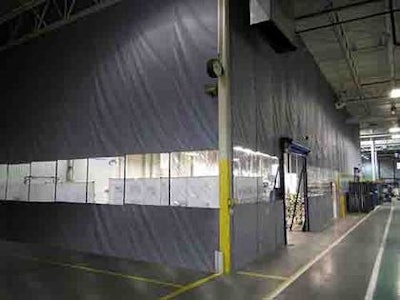
Causes for industrial explosions vary widely from flammable liquids and gases that can easily and accidentally be ignited to seemingly harmless dust shavings that accumulate over time. No matter the potential cause, it’s important for facility managers to understand what the dangers are at their building and to protect against them.
For many manufacturing facilities, this means controlling airborne particulate. Not only is it essential for quality control, it can be a matter of safety. Companies involved in operations that generate any kind of particulate matter are wise to adhere to dust control practices. Such operations include powdered ingredients/spice mixing and packaging, powdered chemical processing, woodworking, painting, and ceramic cutting/grinding to name just a few.
From a safety standpoint, there are many circumstances where a high enough concentration of airborne dust-sized particulate in a closed space can become explosive or flammable. This can even occur with seemingly innocent products — those not normally associate with an explosion hazard. For example, there have been more than 500 grain elevator explosions in the last 40 years in the U.S., according to the U.S. Department of Labor Statistics. Grain dust becomes highly concentrated in an air space and can set off an explosive chain reaction with a small spark.
Dust control plays a role
Unfortunately, it can be easy to overlook dust control when it comes to explosion prevention. There are several methods facilities usually employ when it comes to deterring dust accumulation and contamination from space to space. These include:
- Local exhaust systems — in these systems, a high velocity airflow stream captures particles at the point they are generated and carries them away.
- Exhaust with filtration — here, a high velocity airflow stream captures particles and recirculates them through a filter medium, where they are removed.
- Area exhaust — with this approach, a high volume exhaust fan draws air from the full room volume to an outside vent or recirculates through a filtration/separation device.
- Barrier separation — the simplest approach, this involves a wall or partition between affected areas.
The separation methods outlined above are dependent on moving a volume of air containing the dust particles, which is generally accomplished through the use of exhaust fans through ducts. A local exhaust set up would incorporate some type of hood designed to collect the air and particulate being moved and funnel it into the exhaust ductwork. Area exhaust would include multiple draw points through louvered openings in the ceiling or wall. Either of these methods could, and most likely would, include some type of filtration or particle separator in line to remove particulate from the air stream. This is necessary prior to either recirculation of the air back into the space, or discharge of the air into the atmosphere.
Curtain walls increase efficiency of dust control
Curtain walls can significantly improve the effectiveness of these systems, as well as offer the opportunity for cost savings in the initial cost of the equipment and in direct operating cost.
The smaller the space can be made in any type of exhaustion, the smaller the exhaust equipment can be as specified. Partitioning around a dust source with a curtain wall takes full advantage of this relationship. Reducing the volume of space that needs to be exhausted translates to smaller fan(s). Also, lower air velocity through filter media increases the effective particle separation of the device. Additionally, lower air flow through the filter reduces the frequency required for change out or cleaning.
In some cases, an application will include a temperature differential as well between a dust controlled space and the area surrounding it. Curtain walls are available with several levels of insulation, as needed. These walls can be instrumental in maintaining product integrity and ensuring employee comfort around the space.
Flexibility in a physical barrier
Curtain walls not only condense the volume of space to be exhausted, they are a physical barrier capable of blocking transfer of dust particles from space to space. Curtain walls can be single layer fabric, or multi-layer insulated. They can easily be fitted with clear vision panels for visual communication between spaces. Naturally flexible, they are very durable — able to withstand contact from machinery or product. Curtain walls “bend without breaking,” in contrast to a hard permanent wall.
One of their greatest attributes is that they can easily be re-configured if a space needs to be enlarged or reduced, or the shape of the space footprint needs to change. No “de-construction” is required. Curtain walls are easily installed, can be simply trimmed around conduit, piping, ductwork, etc., and can be anchored to the floor to withstand pressure differential across them. Depending on the application, a curtain wall can be suspended from the room ceiling, or they can be supplied with a standalone framework to hang from. They are available as stationary as well as sliding (suspended from roller track), and can be fitted with strip curtains, personnel doors, or high speed industrial doors for full range of access to the space.
Adding safety and efficiency with fabric curtain walls
When considering possible dangers associated with explosions, facility managers should remember the role air particulate and settled dust from processes can play. In addition to standard exhaust methods, curtain walls can be a wise choice for facilities looking to control dust and prevent explosions. Curtain walls can make exhaust and separation systems more efficient, as well as partition space with minimal set-up or maintenance costs. Regardless of the application, their flexibility, reconfigurable nature and ease of installation saves companies time and money.





















